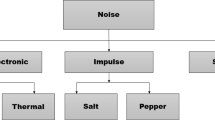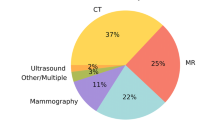Abstract
Purpose Open source software (oss) development for medical imaging enables collaboration of individuals and groups to produce high-quality tools that meet user needs. This process is reviewed and illustrated with OsiriX, a fast DICOM viewer program for the Apple Macintosh.
Materials and methods OsiriX is an oss for the Apple Macintosh under Mac OS X v10.4 or higher specifically designed for navigation and visualization of multimodality and multidimensional images: 2D Viewer, 3D Viewer, 4D Viewer (3D series with temporal dimension, for example: Cardiac-CT) and 5D Viewer (3D series with temporal and functional dimensions, for example: Cardiac-PET-CT). The 3D Viewer offers all modern rendering modes: multiplanar reconstruction, surface rendering, volume rendering and maximum Intensity projection. All these modes support 4D data and are able to produce image fusion between two different series (for example: PET-CT). OsiriX was developed using the Apple Xcode development environment and Cocoa framework as both a DICOM PACS workstation for medical imaging and an image processing software package for medical research (radiology and nuclear imaging), functional imaging, 3D imaging, confocal microscopy and molecular imaging.
Results OsiriX is an open source program by Antoine Rosset, a radiologist and software developer, was designed specifically for the needs of advanced imaging modalities. The software program turns an Apple Macintosh into a DICOM PACS workstation for medical imaging and image processing. OsiriX is distributed free of charge under the GNU General Public License and its source code is available to anyone. This system illustrates how open software development for medical imaging tools can be successfully designed, implemented and disseminated.
Conclusion oss development can provide useful cost effective tools tailored to specific needs and clinical tasks. The integrity and quality assurance of open software developed by a community of users does not follow the traditional conformance and certification required for commercial medical software programs. However, open software can lead to innovative solutions designed by users better suited for specific tasks.
Similar content being viewed by others
References
Salgado R, Mulkens T, Bellinck P et al (2003) Volume rendering in clinical practice, a pictorial review. JBR-BTR 86:215–220
Flohr T, Ohnesorge B, Bruder H et al (2003) Image reconstruction and performance evaluation for ECG-gated spiral scanning with a 16-slice CT system. Med Phys 30:2650–2662
Saito K, Saito M, Komatu S et al (2003) Real-time four-dimensional imaging of the heart with multi-detector row CT. Radiographics 23:E8–8
Lemke AJ, Niehues SM, Hosten N, Amthauer H, Boehmig M, Stroszczynski C, Rohlfing T, Rosewicz S, Felix R (2004) Retrospective digital image fusion of multidetector CT and 18F-FDG PET: clinical value in pancreatic lesions–a prospective study with 104 patients. J Nucl Med 45(8):1279–1286
Spadola L, Rosset A, Seeger L, Motamedi K, Ratib O (2005) Color Fusion MRI: an effective technique for image visualization in a variety of clinical applications. In: SPIE proceedings, Medical Imaging 2005, PACS and Imaging Informatics vol 5748, p 463
Ratib O, Rosset A, Dahlbom M, Czernin J (2005) Navigating the fifth dimension: new concepts in interactive multimodality and multidimensional image navigation. In: SPIE proceedings, Medical Imaging 2005, PACS and Imaging Informatics 2005, vol 5748, p 28
Ratib O (2004) PET/CT image navigation and communication. J Nucl Med 45(Suppl 1):46S–55S
Channin D.S. (2003) Driving market-driven engineering. (Editorial). Radiology 229:311–313
Kantor GS, Wilson WD, Midgley A (2003) Open-source software and primary care EMR. J Am Informet Assoc 10:616
Channin D.S (2002) Integrating the healthcare enterprise: a primer, The fellowship of IHE. Radiographics 22:1555–1560
Rosset A, Spadola L, Ratib O (2004) OsiriX: an open source software for navigating in multidimensional DICOM images. J Digital Imaging 17(3):205–216
Ratib O, Ligier Y, Mascarini C, Logean M, Girard C, Trayser G, Hochstrasser D (1997) Multimedia image and data navigation workstation. Radiographics 17(2):515–521
Rosset A, Spadola L, Ratib O (2004) OsiriX: a new generation of multidimensional DICOM viewer based on new imaging standards. Comput Assisted Radiol Surgery (CARS 2004 Proc) 1268:1247
Chantal R., Antoine R., Osman R (2005) General consumer communication tools for improved image management and communication in medicine. J. Digital Imaging 18(4): 270–279
GNU GCC Compiler. http://www.gcc.gnu.org, accessed September 2006
The Visualization Toolkit (VTK): http://www.public. kitware.com/VTK/, accessed September 2006
The Insight Segmentation and Registration Toolkit (ITK): http://www.itk.org/, accessed September 2006
Papyrus Toolkit, Digital Imaging Unit, Geneva University Hospital: http://www.sim.hcuge.ch/papyrus/01_Papyrus _Presentation_EN.htm, accessed September 2006
DICOM Offis Toolkit: http://www.dicom.offis.de, accessed September 2006
PixelMed Java Toolkit: http://www.pixelmed.com/, accessed September 2006
Author information
Authors and Affiliations
Corresponding author
Rights and permissions
About this article
Cite this article
Ratib, O., Rosset, A. Open-source software in medical imaging: development of OsiriX. Int J CARS 1, 187–196 (2006). https://doi.org/10.1007/s11548-006-0056-2
Received:
Accepted:
Published:
Issue Date:
DOI: https://doi.org/10.1007/s11548-006-0056-2




